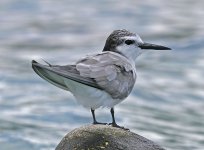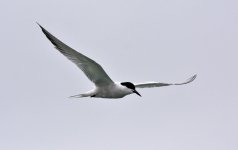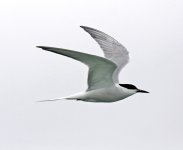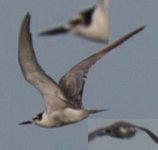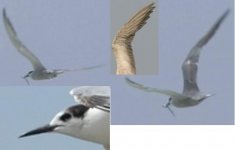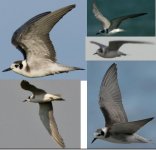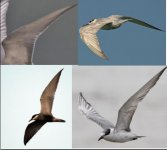-
Welcome to BirdForum, the internet's largest birding community with thousands of members from all over the world. The forums are dedicated to wild birds, birding, binoculars and equipment and all that goes with it.
Please register for an account to take part in the discussions in the forum, post your pictures in the gallery and more.
You are using an out of date browser. It may not display this or other websites correctly.
You should upgrade or use an alternative browser.
You should upgrade or use an alternative browser.
Mystery tern off Singapore (1 Viewer)
- Thread starter Dave B
- Start date
More options
Who Replied?Jane Turner
Well-known member
Well I'd be ruling out Whiskered (on structure) and Bridled (on plumage)
It looks ever so long billed, which would favour White-cheeked over Common and perhaps I shouldn't have been so hasty to rule out bridled. Aleutian is a bird I am 100% unfamiliar with - will have a bit of a look.
edit: its not helped by no one seeming to know that Aleutians look like away from the breeding grounds. That dark bark on the underside of the rear secondaries is promising, but I think there should be a Common Tern-like panel on the inner primaries.
Also the rump looks dark
Guess what, I've no idea either but I'm edging back towards Bridled....will see if I can find what 1st winters look like
It looks ever so long billed, which would favour White-cheeked over Common and perhaps I shouldn't have been so hasty to rule out bridled. Aleutian is a bird I am 100% unfamiliar with - will have a bit of a look.
edit: its not helped by no one seeming to know that Aleutians look like away from the breeding grounds. That dark bark on the underside of the rear secondaries is promising, but I think there should be a Common Tern-like panel on the inner primaries.
Also the rump looks dark
Guess what, I've no idea either but I'm edging back towards Bridled....will see if I can find what 1st winters look like
Last edited:
petemorris
Well-known member
Hi Dave
Clearly Whiskered and White-winged can go. Looks too dark for longipennis Common (was it really that dark in real life?). It's too long billed for Aleutian (as well as several other features being wrong). Can't see it being a Bridled. Have you considered a vagrant Grey-backed Tern just to throw another species into the mix? Otherwise, I think I'd be looking hard at variation in 2 cy longipennis first...
Cheers
Pete
Clearly Whiskered and White-winged can go. Looks too dark for longipennis Common (was it really that dark in real life?). It's too long billed for Aleutian (as well as several other features being wrong). Can't see it being a Bridled. Have you considered a vagrant Grey-backed Tern just to throw another species into the mix? Otherwise, I think I'd be looking hard at variation in 2 cy longipennis first...
Cheers
Pete
Dave B
Well-known member
Hi Dave
Clearly Whiskered and White-winged can go. Looks too dark for longipennis Common (was it really that dark in real life?). It's too long billed for Aleutian (as well as several other features being wrong). Can't see it being a Bridled. Have you considered a vagrant Grey-backed Tern just to throw another species into the mix? Otherwise, I think I'd be looking hard at variation in 2 cy longipennis first...
Cheers
Pete
Hi Pete
We did consider Grey-backed, but the photos I've seen of that species don't show the incongruously long bill of this bird. I've no idea what a non-breeding plumaged/subadult bird might look like.
I went through the various 'most likely' species occurring in the area and came up with the following:
1. Bridled Tern. Leaving aside the apparent grey colouration of the upperparts, the underwing pattern is not right for Bridled - the primaries are too pale for much of their length. And I can't find any photo with a head pattern like this.
2. Common Tern. Assuming that the long bill is an aberration or a photographic artefact, the upperwing might fit for a first year Common. However, I don't think a first year CT can show dusky underparts, and the underwing, with that even dark trailing edge and that odd diagonal grey line across the inner greater coverts (?), is wrong for all ages I think. CTs can have an extensive hood, but I don't think they show a white supercilium like Rob's bird.
3. White-winged Tern. Again, leaving aside the bill length, the wings and tail look way too long for WWT, and the dusky underbody doesn't fit.
4. Aleutian Tern. Adults show a discontinuous dark trailing edge to the underwing - interrupted by a grey wedge on the inner primaries, unlike the continuous dark trailing edge of this bird. The secondaries would usually look blacker than on this bird, but not always. A first winter should not show dusky markings on the underbody.
Structurally, some of us think the bird resembles Bridled more than any other species we're familiar with. But I don't think that's the answer for the reasons summarized above.
Cheers
Dave
Jane Turner
Well-known member
White-cheeked does look possible
http://www.naturspesialisten.no/aimages/hvitkinnterne1_1112013717_1168641802.jpg
http://www.hawar-islands.com/blog/media/blogs/kuwait/2008/WCT_0274.jpg
http://i.pbase.com/o3/42/810742/1/89392569.AinEnPkl.DSC_0089.JPG
http://www.kolkatabirds.com/whitecheekedtern8mar.jpg
http://www.hawar-islands.com/blog/media/blogs/kuwait/2010/WCT_9368.jpg
Bill size is good and I could imagine it could match the plumage
http://www.naturspesialisten.no/aimages/hvitkinnterne1_1112013717_1168641802.jpg
http://www.hawar-islands.com/blog/media/blogs/kuwait/2008/WCT_0274.jpg
http://i.pbase.com/o3/42/810742/1/89392569.AinEnPkl.DSC_0089.JPG
http://www.kolkatabirds.com/whitecheekedtern8mar.jpg
http://www.hawar-islands.com/blog/media/blogs/kuwait/2010/WCT_9368.jpg
Bill size is good and I could imagine it could match the plumage
petemorris
Well-known member
Dave B
Well-known member
Hi Dave
Structurally, Grey-backed and Bridled are similar - Grey-backed is grey though. Here's a Grey-backed I photographed in Polynesia - looks pretty long-billed and similar tones on the upperparts.
Cheers
Pete
Thanks Jane and Pete
White-cheeked looks a lot like Common structurally, whereas this bird has 'the look' of a Bridled-type.
Pete, that photo of Grey-cheeked looks interesting. Are there any photos out there of non -breeding Grey-cheeked in flight?
Thanks
Dave
PS Can Grey-backed ever show dusky underbody markings? If not, then I guess Pete's suggestion of Common Tern becomes the most likely option.
Last edited:
bitterntwisted
Graham Howard Shortt
When I first looked at this yesterday, my inexpert question was, "Why isn't this a Black Tern?" Since someone else has now asked that on the other channel, I've the confidence to ask it here. Is it out of the contenders just on structure?
Graham
Graham
Jane Turner
Well-known member
I think the major argument against is the long very pointed wings and the bill, though the cap shape looks a lot better than the other options.
The apparent dark rump has to be a clue.
The apparent dark rump has to be a clue.
Last edited:
petemorris
Well-known member
Surely it cannot be any species of Chlidonias on structure alone.
I am not aware that Bridled or Grey-backed would ever usually show the grey on the underparts, so this would be something to explain?
On the otherhand, longipennis routinely does and the 2cy plumage (the old portlandica) is probably poorly known. Coupled with the fact that they often look long-winged and long-billed (see attached - though these are adult summer of course) I think this may still be the best option.
Cheers
Pete
I am not aware that Bridled or Grey-backed would ever usually show the grey on the underparts, so this would be something to explain?
On the otherhand, longipennis routinely does and the 2cy plumage (the old portlandica) is probably poorly known. Coupled with the fact that they often look long-winged and long-billed (see attached - though these are adult summer of course) I think this may still be the best option.
Cheers
Pete
Attachments
Last edited:
Jane Turner
Well-known member
Does longipennis have the same underwing pattern as western Commons (I guess I should check) . This bird really does not have translucent inner primaries. Interestingly when I was looking at White-cheeked terns before i found some with a Common Tern-like underwing, but rather more with an underwing like this bird.
Jane Turner
Well-known member
Dave B
Well-known member
and to answer my own question - no - underwing pattern as expected for Common Tern.
I'm still seeing "less wrong" with White-cheeked Tern than other options... not that that means it is one.
Some really helpful and thoughtful insights have emerged on this thread.
I originally put the pics up in the hope that someone might say "Ah - that exactly fits xxx!" Since that hasn't yet happened, I guess we will have to put this down as one that got away.
Pete's question about the apparent darkness of tone of the upperparts is a critical one which we can't answer. Jane's point about the rump is also well-made, but I can't quite see enough on the photos to be sure what's going on there.
The apparent complete dark trailing edge to the wing doesn't fit Common or Aleutian, and I think we can rule out Grey-backed due to dusky underparts. All of which leaves White-cheeked as a possible candidate. But at the end of the day, I don't think I can see enough of the bird to make a solid id...
At least it alerts us to be on the look out for White-cheeked.
Dave
Jane Turner
Well-known member
I'm confused looking at WC Tern pics on the web - as I said there are some with underwings like a Common, and some with a uniform dark trailing edge to the wing.
A grey rump is supposed to be a feature though
A grey rump is supposed to be a feature though
Dave B
Well-known member
I'm confused looking at WC Tern pics on the web - as I said there are some with underwings like a Common, and some with a uniform dark trailing edge to the wing.
A grey rump is supposed to be a feature though
Me too Jane! Perhaps someone who knows White-cheeked well could summarize the diagnostic field characters in various plumages.
Longipennis Common can show a grey central rump in some plumages, though it isn't prominent, and can look white (see Here and here).
Dave
Jane Turner
Well-known member
For completeness, here are the stuctural reasons why Black Tern, (and to a greater extent White-winged Black Tern) are a bad fit.
Also look at the underwing pattern.
Whiskered is the most capable of looking like a Sterna tern - I'll look at that next
edit: Structurally a little better but still not great underwing
Also look at the underwing pattern.
Whiskered is the most capable of looking like a Sterna tern - I'll look at that next
edit: Structurally a little better but still not great underwing
Attachments
Last edited:
petemorris
Well-known member
I agree that the underwing pattern is not typical for an adult summer longipennis. What I am less sure about is how a 2cy would look in moult in November. The outer primaries look knackered from what you can see.
The dirty grey on the underparts could fit longipennis or White-cheeked, but the former is of course infinitely more likely, and therefore safely eliminating that common and expected form in a rarely seen 2cy (1s - 2w) plumage would be my starting point. Would a bird in this plumage and this state of moult show the 'expected' wing pattern??
Cheers
Pete
The dirty grey on the underparts could fit longipennis or White-cheeked, but the former is of course infinitely more likely, and therefore safely eliminating that common and expected form in a rarely seen 2cy (1s - 2w) plumage would be my starting point. Would a bird in this plumage and this state of moult show the 'expected' wing pattern??
Cheers
Pete
Jane Turner
Well-known member
Pete...as far as I am aware, the pale underwing inner primary wedge gets more pronounced with wear on common terns, not that I've seen many "portlandicas".
HOWEVER..... there must be some sort of process that can make an inner primary wedge disappear, on account of the variation in WCTs we have found.
Aside from the underwing pattern, the other problem for Common Tern is the apparent dark rump.
I sound like I'm advocating WCT, which I'm not really, just exploring!
HOWEVER..... there must be some sort of process that can make an inner primary wedge disappear, on account of the variation in WCTs we have found.
Aside from the underwing pattern, the other problem for Common Tern is the apparent dark rump.
I sound like I'm advocating WCT, which I'm not really, just exploring!
Jane Turner
Well-known member
Here are some 2cy Commons, though not longipennis
http://www.netfugl.dk/pictures/birds_uploaded/8893_IMG_2113komp9.jpg
http://www.netfugl.dk/pictures/birds_uploaded/8890_IMG_2162komp7.jpg
http://www.netfugl.dk/pictures/birds_uploaded/8893_IMG_2113komp9.jpg
http://www.netfugl.dk/pictures/birds_uploaded/8890_IMG_2162komp7.jpg
Jane Turner
Well-known member
Users who are viewing this thread
Total: 2 (members: 0, guests: 2)




